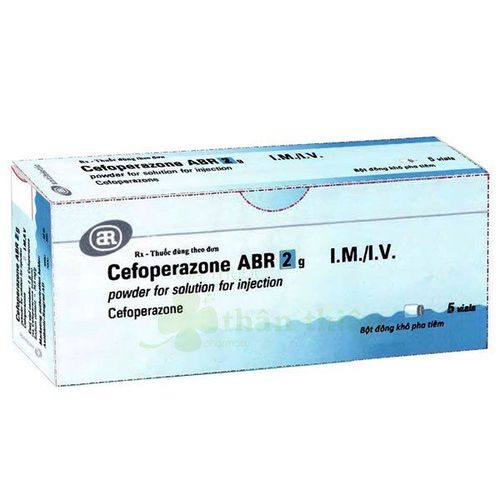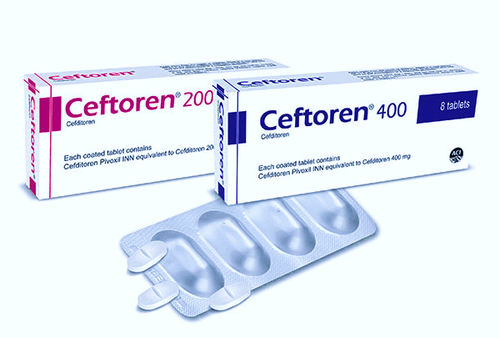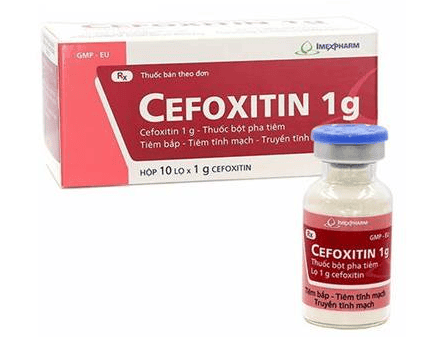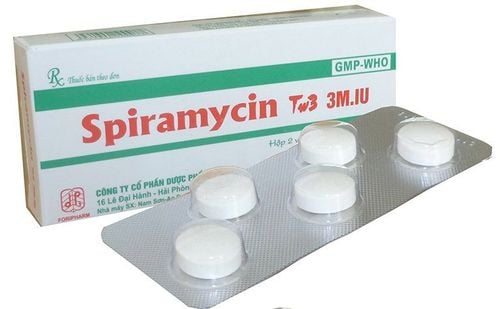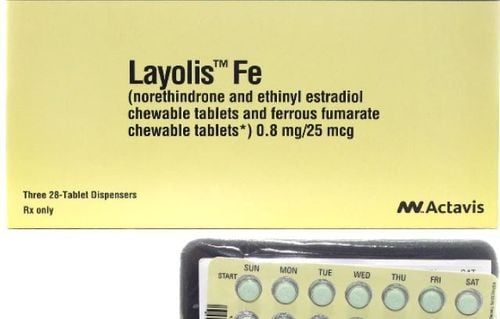This is an automatically translated article.
Zanmite 500 mg is an antibiotic with anti-parasitic effect, belonging to the group of anti-infectives, antivirals, antifungals. To better understand Zanmite 500mg, let's learn more in the article below.
1. What is Zanmite 500 mg?
Zanmite's main ingredient is Cefuroxim, belonging to the 2nd generation Cephalosporin antibiotic group, which is prepared in the form of 500mg film-coated tablets. The drug is manufactured by Hataphar Pharmaceutical Company.Pharmacodynamics of the drug Zanmite 500 mg:
The precursor of Cefuroxim is Cefuroxim axetil, when not hydrolyzed to cefuroxime, this precursor after being absorbed has very little antibacterial activity in the body. The antibiotic Cefuroxime has antibacterial activity due to inhibition of bacterial cell wall synthesis by direct binding to essential target proteins (penicillin-binding proteins). The cause of drug resistance can be caused by bacteria secreting cephalosporinase enzymes or by alteration of penicillin-binding proteins. Cefuroxime has very specific antibacterial activity and is effective against many common pathogens, including cephalosporinase or beta-lactamase-producing strains of both Gram-positive and Gram-negative bacteria. Cefuroxime is particularly active against many beta-lactamase enzymes of Gram-negative bacteria. Antibacterial spectrum:
Cefuroxime is active against aerobic and anaerobic Gram-positive and Gram-negative cocci, including most penicillinase-producing Staphylococcus strains, and is active against Gram-negative intestinal bacteria. Cefuroxime has high activity, so it has a low minimum inhibitory concentration (MIC) against Streptococcus strains (groups A, B, C and G); strains of Gonococcus and Meningococcus. Strains of Clostridium difficile, Pseudomonas spp., Campylobacter spp., Acinetobacter calcoaceticus, Legionella spp. are not sensitive to cefuroxime. Staphylococcus aureus and methicillin-resistant Staphylococcus epidermidis are also resistant to cefuroxime. Listeria monocytogenes and most Enterococcus strains are also resistant to cefuroxime. Studies on drug resistance in Vietnam show that Haemophilus influenzae strains isolated in healthy children have a high rate of resistance to Cefuroxime. In healthy children, according to the announcement No. 4 (1999) of ASTS, the level of resistance to Cefuroxime of all strains of H.influenzae is 27%. This situation is alarming and shows the need to limit the use of broad-spectrum antibiotics, which should only be used in patients with severe infections. Absorption:
After oral administration, Cefuroxim axetil will be absorbed by the body through the gastrointestinal tract and rapidly hydrolyzed in the intestinal mucosa and blood to release Cefuroxime into the circulation. The drug is best absorbed when the patient takes the drug right with a meal.
Distribution:
The pharmacokinetics of Cefuroxime are linear with oral doses from 125 to 1000 mg. After repeated oral administration of 250 to 500 mg, no accumulation of Cefuroxime occurred. Depending on the method used, protein binding has been reported to be 33 to 50%. The plasma half-life of Zanmite is approximately 70 minutes and may be longer in patients with renal impairment and in neonates. Cefuroxime is widely distributed throughout the body, including sputum, pleural fluid, synovial fluid, bone, and aqueous humor. The volume of distribution in healthy adult subjects ranges from 9.3 to 15.8 liters/1.73 m2. Metabolism and Elimination: Cefuroxime is not metabolised and is eliminated unchanged, approximately 50% by glomerular filtration and 50% by tubular secretion. The drug reaches high concentrations in the urine. Following injection, most of the administered dose is eliminated within 24 hours, with the majority within 6 hours. Probenecid inhibits renal tubular elimination of cefuroxime, resulting in elevated and prolonged plasma concentrations of cefuroxime. Cefuroxime is only excreted in the bile in very small amounts. Serum concentrations of cefuroxime are reduced by dialysis.
2. What are the uses of Zanmite 500 mg?
Zanmite is used to treat mild to moderate infections in the upper and lower respiratory tract, skin and soft tissue infections, urogenital - urinary tract infections... Specifically:
Lower respiratory tract infections : Includes pneumonia, caused by Streptococcus pneumoniae, Haemophilus influenzae (including ampicillin-resistant strains), Klebsiella spp., Staphylococcus aureus (penicillinase and non-penicillinase producing strains), Streptococcus pyogenes and Escherichia coli; Urinary tract infections caused by Klebsiella spp and Escherichia coli; Skin and skin structure infections caused by Streptococcus pyogenes, Staphylococcus aureus (penicillinase-producing and non-penicillinase-producing strains), Enterobacter spp, Escherichia coli, Klebsiella spp; Sepsis caused by Staphylococcus aureus (penicillinase-producing and non-penicillinase-producing strains), Streptococcus pneumoniae, Escherichia coli, Haemophilus influenzae (including ampicillin-resistant strains) and Klebsiella spp; Meningitis caused by Streptococcus pneumoniae, Haemophilus influenzae (including ampicillin-resistant strains), Neisseria meningitidis and Staphylococcus aureus (penicillinase and non-penicillinase producing strains); Gonorrhea: Uncomplicated and disseminated gonococcal infection caused by Neisseria gonorrhoeae (penicillinase-producing and non-penicillinase-producing strains) in both men and women; Bone and joint infections caused by Staphylococcus aureus (penicillinase-producing and non-penicillinase-producing strains). 3. Contraindication of the drug Zanmite 500 mg Patients who are allergic to any ingredient or excipients of the drug Zanmite Do not use the drug for infants under 3 months of age 4. Side effects of the drug Zanmite 500 mg Side effects of Zanmite are rare and almost all mild, occurring in a short time. Some patients during the use of Zanmite may develop gastrointestinal disorders (diarrhea, nausea, vomiting) or pseudomembranous colitis, but this is very rare. Other side effects: Erythema, skin necrosis, urticaria, fever, serum sickness, eosinophilia, elevated liver enzymes. There may also be headache, leukocytosis, transient increase in liver enzymes. Any side effects that occur in the patient should be reported to the doctor for advice.
5. Drug interactions
Zanmite reduces gastric acidity, which may lead to lower bioavailability of Cefuroxime axetil when administered in the fasted state and tends to be less effective in enhancing absorption after meals. Cefuroxime axetil may have some effect on the gut microbiota, leading to decreased effectiveness of combined oral contraceptives and decreased estrogen reabsorption. Cefuroxime is eliminated by glomerular filtration and tubular secretion. Therefore, concomitant use with Probenecid is not recommended. Since co-administration of Probenecid significantly increases the peak drug concentration, serum concentration time, AUC and half-life of Cefuroxime. Concomitant use of Zanmite with oral anticoagulants may increase the INR.
6. Be careful when using Zanmite 500mg
Exploiting the most history are patients who have been allergic to treatment with Cephalosporin, Penicillin... The patient is seriously ill, has renal dysfunction. Use with caution in patients taking potent diuretics. During the use of the drug, the patient's condition must be monitored, if a superinfection occurs, the drug must be stopped immediately. Caution should be exercised when prescribing broad-spectrum antibiotics to patients with gastrointestinal diseases, especially inflammatory bowel disease. Pregnancy and breast-feeding: There is no evidence of the effects of Zanmite on the fetus, but caution should be exercised in early pregnancy. Cefuroxime is excreted in breast milk at low concentrations, so it is not considered to affect the nursing infant but still requires attention and advice from a doctor. Driving and operating machinery: The drug can cause drowsiness, dizziness, so it should be used with caution.
7. How to use Zanmite 500 mg effectively
Drugs for oral use. Do not crush or mix the medicine with other mixtures.
Take the medicine right after eating is the most ideal time
Dosage (each course of treatment will usually last from 5 to 10 days). Dosage for adults and children is different.
For adults:
Most common infections, mild to moderate respiratory tract infections, pyelonephritis, Lyme disease (adults and children over 12 years old) use 250mg each time x2 times/day. Particularly for Lyme disease, the treatment time can last up to 20 days; For adults with urinary tract infections: 125 mg x 2 times/day; With severe lower respiratory tract infection or suspected pneumonia: 500mg x 2 times/day; People with uncomplicated gonorrhea: a single dose of 1g. For young children:
Most common infections in children: 125mg x 2 times/day (maximum 250mg/day); Children with otitis media or more severe infections: 250 mg x 2 times/day (maximum 500mg/day); For patients with renal failure, on renal dialysis, the elderly: the usual dose should not exceed 1g/day. Treatment of overdose: When a patient has an acute overdose, nausea, vomiting, diarrhea, convulsions may appear. promptly treated.
Handling missed dose: Take the dose as soon as you remember. Do not take a 2nd dose to make up for a dose you may have missed.
Above are the uses, doses and how to use Zanmite 500 mg. To ensure the safety and effectiveness of treatment, patients need to take the drug exactly as prescribed by the doctor.
Please dial HOTLINE for more information or register for an appointment HERE. Download MyVinmec app to make appointments faster and to manage your bookings easily.




